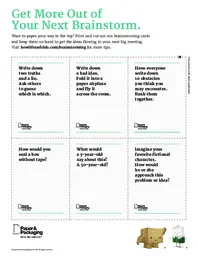
Let’s make it rain! Brainstorms have an important role in the workplace, and we’ve come up with some ways to make them better.
Our deck of brainstorming prompt cards gives you 52 ways to turn your ’storm sessions from drizzle to downpour. It features icebreakers (“Play a game of telephone”), conceptual exercises (“Imagine making a time capsule. What goes inside?”) and invitations to free your thinking (“Don’t break the next silence”). Download them, print them out, glue the pages to sheets of card stock and cut them up—you’ll be left with a deck of brainstorming session ideas that can help make your meetings more productive.
If you’re ready to try a different spin on the traditional brainstorm, though, there’s another technique your team might want to give a shot for heightened productivity, greater equity among team members and a faster decision-making process.
Brainwriting—so called because it emphasizes written contributions that ladder up to oral contributions and a final decision—is one of the brainstorming techniques that is becoming popular in leading organizations. Google Ventures reportedly uses the approach, calling it “note-and-vote” because in its iteration, people individually make notes of their ideas, then vote on them as a group.
Google Ventures' note-and-vote style boils down to six key steps:
- Team members write down their ideas for five to 10 minutes, individually, without discussion.
- Each person reviews his or her list for two minutes, selecting one or two favorites—again, individually.
- Out loud, each person shares his or her top ideas without elaborating on them. One person writes each idea on a large-scale notepad.
- Each person—without discussion—chooses a favorite from the group’s ideas and writes it on a piece of paper.
- Out loud, everyone shares their favorite. One person tallies the results.
- The team leader selects the final direction, either going by the group’s collected votes or simply choosing what she thinks is the strongest idea.
This approach to brainstorming techniques has been shown to be more productive than regular unstructured sessions. Standard brainstorming—everyone in a room with the freedom to talk, with ideas developing as group members tease them out—has its place as a team-building exercise, but it has shortcomings when it comes to the nitty-gritty. Without a structure like the type provided by our downloadable brainstorm cards, it can lead to groupthink, with participants simply echoing what they’re hearing from others, and it can inhibit some team members who are afraid the group will shoot down their ideas.
If note-and-vote feels right for your workplace, try one of these brainstorming session ideas below, each a variation of brainwriting:
- Pass the buck: Instead of participants sharing their top two ideas with the group, everyone puts each of their top two ideas on slips of paper, then puts them into a bowl. Participants draw two ideas each and come up with a third based on those two new ideas. (This technique can be particularly useful in teams that thrive on competition, without alienating team members who shy away from going up directly against colleagues.)
- Go incognito: Keeping participants anonymous can increase fluency and flexibility of ideas, according to research in Journal of Applied Social Psychology. Issue the same paper and writing utensils to all team members, and ask them to write in block letters, keeping ideas limited to one or two words.
- Start with a mini-brainstorm: Beginning with group ideation can increase the number of ideas that team members develop individually. Consider starting the session with a three-minute group brainstorm, then going to note-and-vote. This gets people’s creative juices flowing while maintaining the benefits of brainwriting.
Each example of brainstorming activities listed above brings a different flair to a group’s session—and each has potential to maximize your team’s time, talent and energy.
If you're looking for more ways to be productive, take a look at these printable templates.





